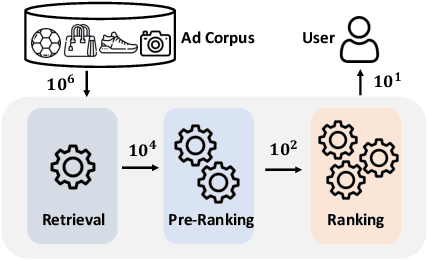Siyuan Lou
COPR: Consistency-Oriented Pre-Ranking for Online Advertising
Jun 06, 2023



Abstract:Cascading architecture has been widely adopted in large-scale advertising systems to balance efficiency and effectiveness. In this architecture, the pre-ranking model is expected to be a lightweight approximation of the ranking model, which handles more candidates with strict latency requirements. Due to the gap in model capacity, the pre-ranking and ranking models usually generate inconsistent ranked results, thus hurting the overall system effectiveness. The paradigm of score alignment is proposed to regularize their raw scores to be consistent. However, it suffers from inevitable alignment errors and error amplification by bids when applied in online advertising. To this end, we introduce a consistency-oriented pre-ranking framework for online advertising, which employs a chunk-based sampling module and a plug-and-play rank alignment module to explicitly optimize consistency of ECPM-ranked results. A $\Delta NDCG$-based weighting mechanism is adopted to better distinguish the importance of inter-chunk samples in optimization. Both online and offline experiments have validated the superiority of our framework. When deployed in Taobao display advertising system, it achieves an improvement of up to +12.3\% CTR and +5.6\% RPM.
Capturing Conversion Rate Fluctuation during Sales Promotions: A Novel Historical Data Reuse Approach
May 22, 2023



Abstract:Conversion rate (CVR) prediction is one of the core components in online recommender systems, and various approaches have been proposed to obtain accurate and well-calibrated CVR estimation. However, we observe that a well-trained CVR prediction model often performs sub-optimally during sales promotions. This can be largely ascribed to the problem of the data distribution shift, in which the conventional methods no longer work. To this end, we seek to develop alternative modeling techniques for CVR prediction. Observing similar purchase patterns across different promotions, we propose reusing the historical promotion data to capture the promotional conversion patterns. Herein, we propose a novel \textbf{H}istorical \textbf{D}ata \textbf{R}euse (\textbf{HDR}) approach that first retrieves historically similar promotion data and then fine-tunes the CVR prediction model with the acquired data for better adaptation to the promotion mode. HDR consists of three components: an automated data retrieval module that seeks similar data from historical promotions, a distribution shift correction module that re-weights the retrieved data for better aligning with the target promotion, and a TransBlock module that quickly fine-tunes the original model for better adaptation to the promotion mode. Experiments conducted with real-world data demonstrate the effectiveness of HDR, as it improves both ranking and calibration metrics to a large extent. HDR has also been deployed on the display advertising system in Alibaba, bringing a lift of $9\%$ RPM and $16\%$ CVR during Double 11 Sales in 2022.
 Add to Chrome
Add to Chrome Add to Firefox
Add to Firefox Add to Edge
Add to Edge